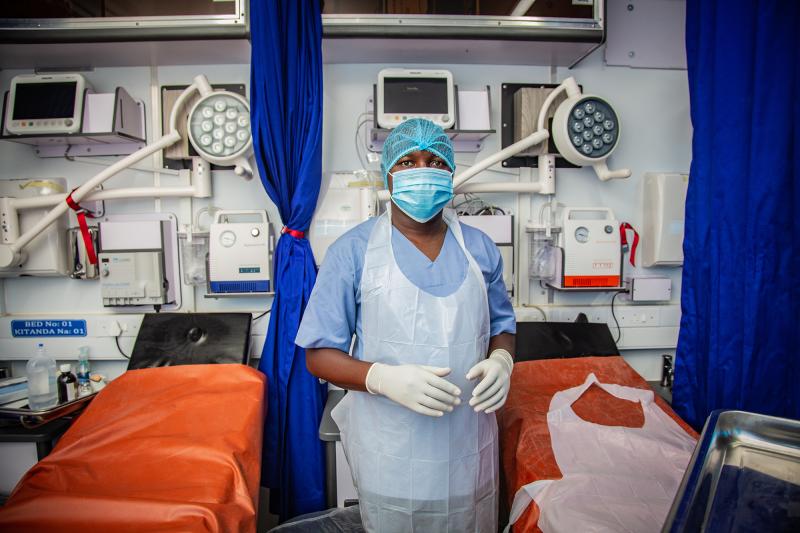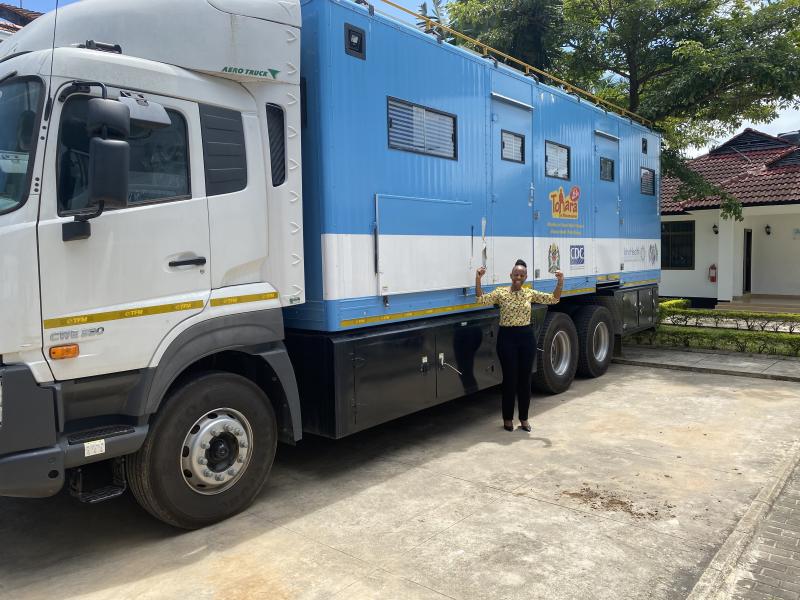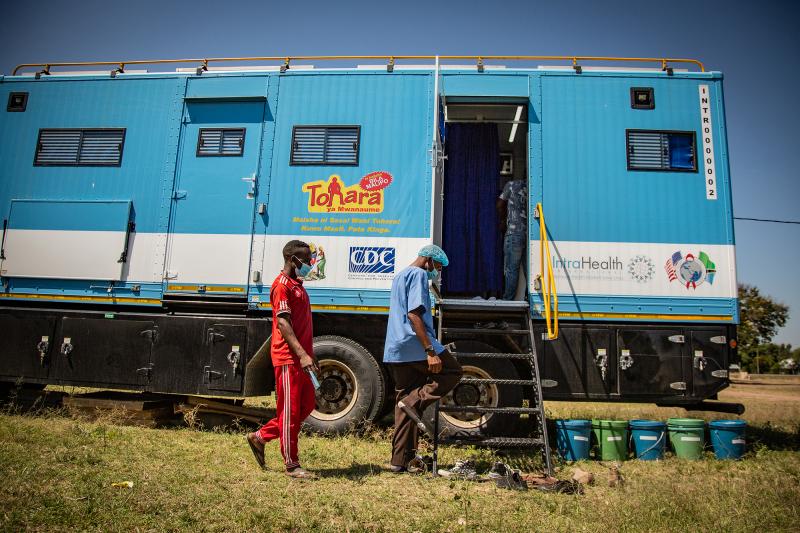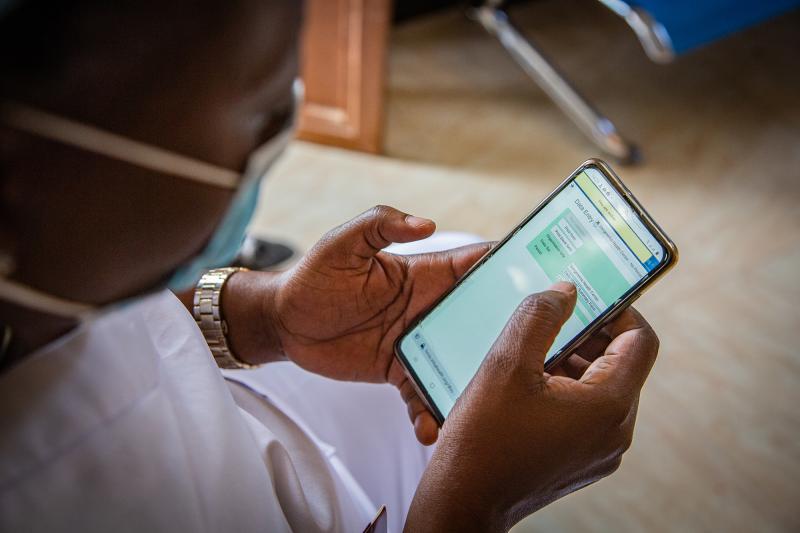Where We Work
See our interactive map


A health worker waits for clients in a mobile clinic van in Tanzania. Photo by Rasheed Hamis/DDC International for IntraHealth International.
Lucy Mphuru on how her team exceeded targets despite the pandemic.
Lucy Mphuru and her team have been providing HIV services to hundreds of thousands of clients in Tanzania for 14 years. But when COVID-19 hit the country in 2020, the pandemic threatened to halt these services.
So Lucy and her team pivoted quickly.
They developed their own creative new approaches to make sure their clients could still access high-quality health care while ensuring the safety of frontline health workers, staff, and the clients they served—and they got results. In fact, they achieved 117% of the Tohara Plus project’s target in 2020, providing over 186,000 adolescent and adult men in Tanzania’s northern regions of Mara, Mwanza, Shinyanga, and Simiyu with voluntary medical male circumcision (VMMC) services, which lower men’s risk of acquiring HIV through heterosexual sex by around 60%.Between meetings and facility visits, Mphuru found a sliver of time to sit down with us to talk about how they did it.
When COVID-19 first started in March 2020, IntraHealth suspended all Tohara Plus VMMC outreach campaigns and community activities that attract big gatherings. So, with our project partners, we quickly adapted.
We focused on 29 static sites and created 42 satellite static sites in more remote locations using interactive geospatial mapping and having conversations with communities. This allowed us to prioritize the areas with high numbers of uncircumcised men and bring services closer to potential clients. We extended daily working hours and included weekend hours so clients had easier access. And we integrated COVID-19 awareness and prevention measures into routine VMMC services like facemasks, handwashing stations, and pre-booked clients and scheduled time slots for adequately spaced appointments to avoid facility congestion.
We also relied heavily on “no contact” tools such as mobile phones and apps to send SMS messages, provide toll-free hotline calls, collect data, and facilitate communication between volunteer community agents, clients, and facilities.
Another really important tool for us was our mobile clinic vans, which we started using in late 2020. They allow us to take services directly to clients, rather than the other way around. They are fully equipped with all the supplies and equipment needed to provide VMMC services at any time and location. We take them to areas with high numbers of potential clients, such as along highways to target long safari truck drivers, in mining places to target miners, along the Lake Victoria Islands to target fisherfolks, and in hard-to-reach areas.
READ: Four Ways We’re Adapting HIV Services during COVID-19 in Tanzania

Lucy Mphuru in front of a mobile clinic van. Photo by IntraHealth International.

A mobile clinic van in Tanzania. Photo by Rasheed Hamis/DDC International for IntraHealth International.
We already had strong relationships with the government and were part of national, regional, and district COVID-19 Rapid Response Teams. Because of that, we were well informed and aligned our implementations in accordance with the national guidance and donor requirements.
We engaged every person within the organization and worked closely with government authorities from the national to community level to adapt our implementation to the “new normal” of working.
First, we’ve been using formal and informal workplace-based approaches to engage employers and workers. For example, we co-designed a partnership with fisher folks, beach management units (BMU), small-scale miners, and boda boda (motorcycle taxi) drivers in Tanzania. These networks of leaders supported us to set up client-centered services, which helped increase the number of clients receiving VMMC services. With the BMUs and fisherfolk in the Lake Victoria Islands, we provided VMMC services to 1,642 males in three weeks.
We also partnered with management teams and associations at different workplaces. These include sugar and tobacco plantations, miners, and cotton ginnery factories. We built a great relationship with the ginnery management and our project team was offered space to set up a medical tent for circumcising consenting men. We were able to work with management to ensure that employees who were circumcised were granted 7-14 paid leave days for their recovery and their employment was retained so they could go back to work after healing. Thanks to those agreements, 90 clients were circumcised in two weeks.
Second, we use a human-centered design approach to address behavioral barriers and engage hard-to-reach adult men. We work with community volunteer agents, popular opinion leaders, local leaders, peer networks, and satisfied VMMC clients to reach interested new clients in the community. Most of these interactions are done through one-on-one engagement with individual men or small groups of men in places where they spend a lot of their time—barber shops, motorcycle taxi stops, among others—and mobilize them through safe and acceptable interpersonal conversation.
We conduct real-time performance monitoring daily.
Third, we are a data-driven team. We conduct real-time performance monitoring daily and have weekly service delivery surge data dashboards for each facility. This continuous quality improvement approach allows us to make real-time decisions that improve performance and maintain service quality.
At the beginning of COVID-19, IntraHealth also institutionalized the DHIS2 Touch mobile app on phones, tablets, and project laptops to facilitate remote daily data collection and live reporting by each site while promoting data quality and use. Project regional technical advisors, monitoring and evaluation officers, and facility VMMC site managers monitor clinic performances daily to troubleshoot any challenges that hinder services at static sites or pose an increased risk of COVID-19 transmission to clients or health workers.
And we invest in and rely on local partnerships. We work closely with local organizations, including Afya Plus, which is a local IntraHealth affiliate. We’ve helped them strengthen their governance, organization, and board of directors structures and systems so they can partner with the government of Tanzania, local civil society, and the private sector to improve the quality and accessibility of Tanzania’s health care system. We’ve also worked with them through our ASAP project to help build their capacity to receive direct funding from the US government and manage those funds. As part of this consortium, Afya Plus signed a sub-agreement to provide VMMC services in the Mara region, which they were able to scale up after achieving specific milestones. Now, we have a strong local partner providing VMMC services in Tanzania who we rely on and work with during COVID-19.
READ: New Afya Plus to Improve Health Care Quality and Accessibility in Tanzania

A health worker in Tanzania uploads facility data using a mobile phone. Photo by Rasheed Hamis/DDC International for IntraHealth International.
Despite IntraHealth’s remarkable achievements since the inception of VMMC services in Tanzania, we still need to close the gap and reach more adult males who are at risk of HIV. Ambition funding was a global competitive funding opportunity from PEPFAR that we won to address this gap. The award signifies that our refined strategies and innovations—which have evolved over years—are working. The funds help us continue to achieve our targets, close the service gap, and invest in meaningful working relationships with all levels of the Tanzanian government.
The health care system in Tanzania is facing a critical shortage of health workers. They are not equitably distributed, there is limited infrastructure, and pandemic preparedness challenges remain. COVID-19 overwhelmed the health system at the beginning due to limited knowledge and technical competence to manage it.
We need to always be prepared with equitable and adequately skilled human and nonhuman resources.
Investments have now been put in place by the government of Tanzania in collaboration with other stakeholders to help the health system manage COVID-19 in an informed, systemic manner. Now, the health workforce is more knowledgeable about the disease and COVID-19 has shown how important preparedness is for the health system. We need to always be prepared with equitable and adequately skilled human and nonhuman resources, such as technology, infrastructure, funds, and tools.
This goes beyond having excellent training institutions to extend to recruitment, sustainable retention programs, a motivated workforce, meaningful data utilization, and adequate budgetary allocation to improve overall system resilience and prepare for future crises.
IntraHealth’s Tohara Plus Project leads a consortium that includes two local partners—the Tanzania Youth Alliance (TAYOA) and IntraHealth’s local affiliate, AFYA Plus. It is funded by the US Centers for Disease Control and Prevention (CDC) under the President's Emergency Plan for AIDS Relief (PEPFAR).
Get the latest updates from the blog and eNews




